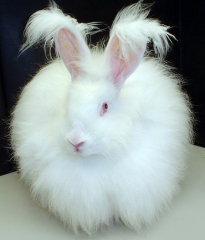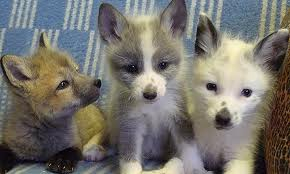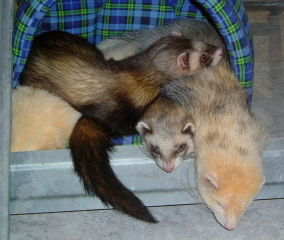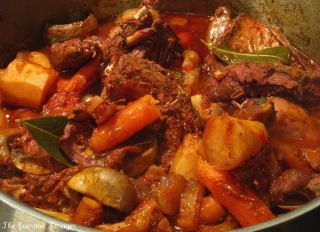I’ve spent the last few weeks researching rabbits. I have my reasons.
First reason is that K indicated an interest in spinning, and I thought I’d look into how viable it would be to have a little cottage industry setup selling yarn, and possibly raw fleece. (Answer: limited to zero for making any actual money/profit)
Your basic wool animal is a sheep, but I dislike sheep. I’ve never met a bright one, or one that didn’t stink, although I’ve been assured by people who like sheep that they don’t inherently stink. After sheep, there are goats (cashmere goats, which produce cashmere, and angora goats, which produce mohair), alpacas, and angora rabbits (which produce angora).
At the same time, I’ve been reading and thinking about the Russian domestication experiment with silver foxes. Short version: the researchers took mostly-wild foxes from a fur farm and bred them for domestication, using a lowered fear response to humans as demonstrated by least avoidance behaviours and lowered agression as the main selection criterion. Within 8 generations they had adult foxes which wagged their tails like dogs, whined and fawned for attention from their keepers, and showed a diverse range of colouring and coat patterns. After 50-some years of the breeding program, the domesticated foxes are adorable, completely domesticated housepets.
I’m absolutely fascinated with genetics, and I really want to replicate the experiment. But not with foxes. Keeping foxes is illegal in Australia (even assuming we could live-trap enough for a starting gene pool), and there are hefty fines for doing it. I considered ferrets, but they’re tricky to breed (female ferrets which go into season and aren’t bred will often die!) and there probably isn’t much call for super-domesticated ferrets. Ferret fanciers don’t mind the slightly bitey nature of ferrets, and non-ferret-fanciers won’t have a ferret anyway. Rats are an option, but again – what do you do with your super-domesticated rats? Rat fanciers will keep rats anyway, and other people will still dislike them. Rabbits, though – rabbits are a possibility.
Rabbits are only semi-domesticated, in that they still display fear responses and avoidance behaviours towards humans (unlike labrador dogs, for example, or even domestic cats), so there’s the potential for the experiment to show obvious results. They reproduce fast, which is desirable to get results in a resaonable timeframe. They’re easy to get, legal to keep, and thay’re also useful. Angora rabbits are a possible wool animal, and I was considering keeping rabbits as meat animals anyway.
However, before getting too heavily invested in the idea of keeping rabbits for meat, I thought it might be wise to try it. I’d never (knowingly) eaten rabbit. So I made rabbit stew the other day. I got a farmed rabbit form the butcher, and followed instruction on youtube to debone it (I was fine with the tiny little carcass, but K had to leave the room, and my mother made slightly horrified noises about eating Flopsy, Mopsy, or Cottontail when I told her about it). One slow cooker later, rabbit stew.
Nom nom nom. Turns out that I like rabbit. Especially with a bit of red wine, tomatoes & garlic.
As an aside, I have no idea how fibre farmers make enough money to keep going. Not only is it a negative sum, financially, to keep Angora rabbits, this is also the case for angora goats, cashmere goats, and alpacas.
The goats become (just) financially viable if you include the savings from milking them (and using that milk instead of buying milk) and eating the unwanted baby goats produced to keep the does in milk (instead of buying meat). Alpacas, similarly, become (just) viable if you breed them once a year and include the savings from eating the young alpacas instead of buying meat. Rabbits are only viable to keep for wool if you can reduce the time spent checking their health, handling them, and making sure they have food & water down to 1 minute per rabbit per day or less. How do farmers survive???
-
Credits:
- Image sourced from Wikimedia Commons: File:Fluffy_white_bunny_rabbit.jpg
- Image (but not recipe) sourced from Environmental Graffiti
- Image sourced from The Gourmet Forager
- Image sourced from Wikimedia Commons: File:Fretts_301004_selbstfotografiert,_GNU-FDL.jpg
- Rabbit Stew recipe: BestRecipes.com.au



